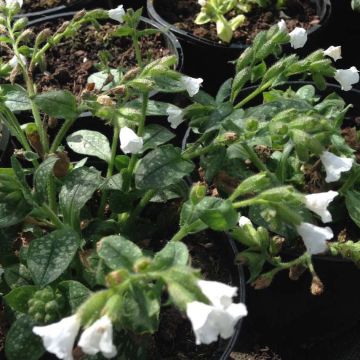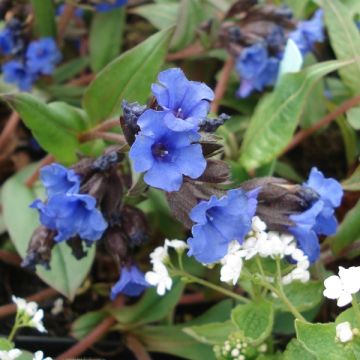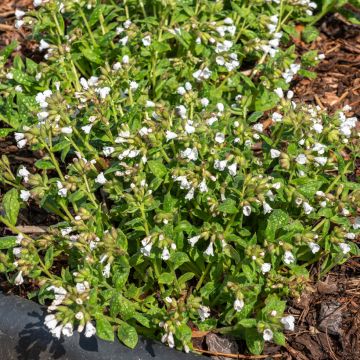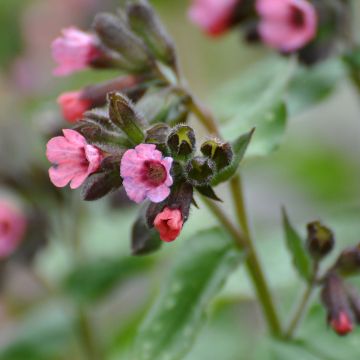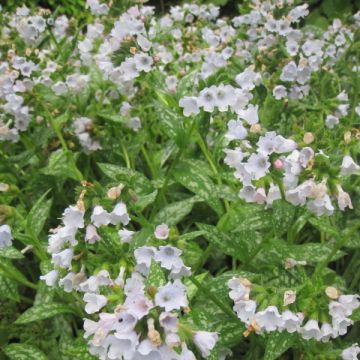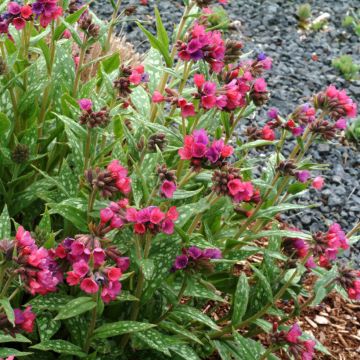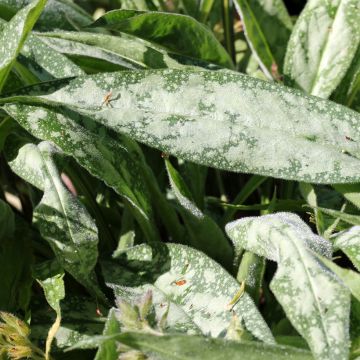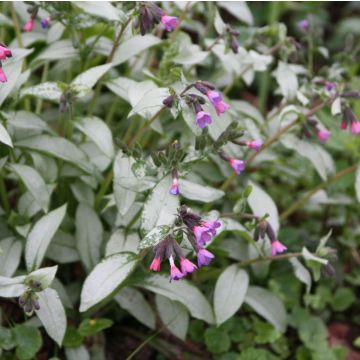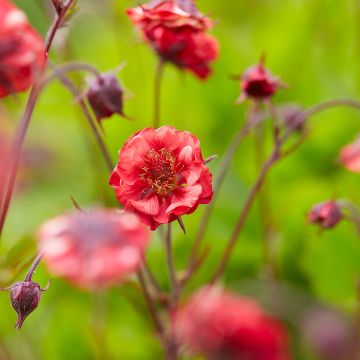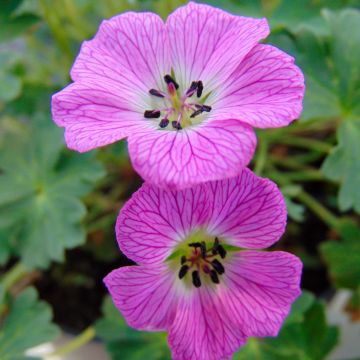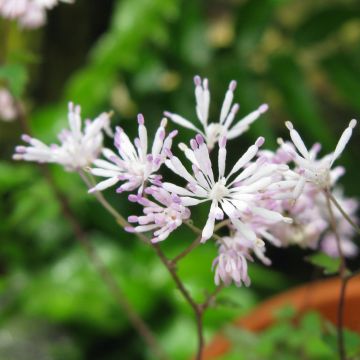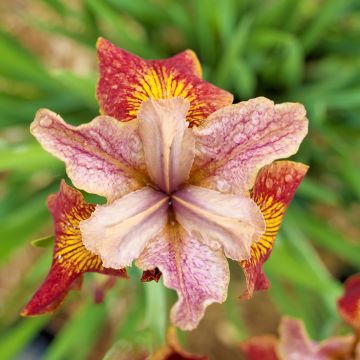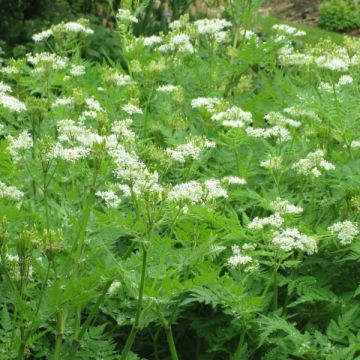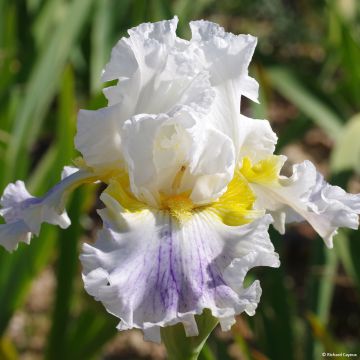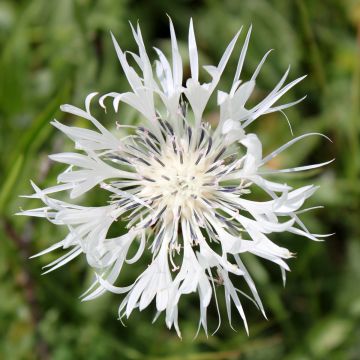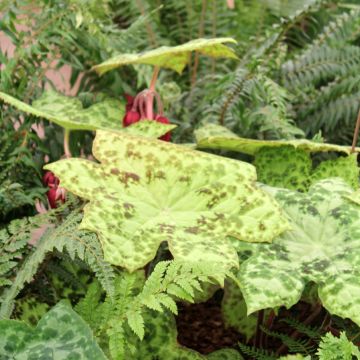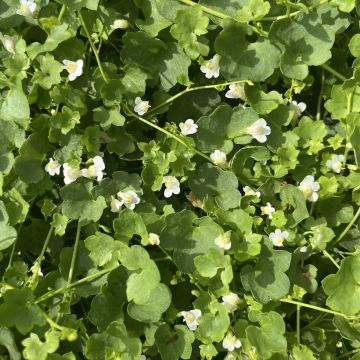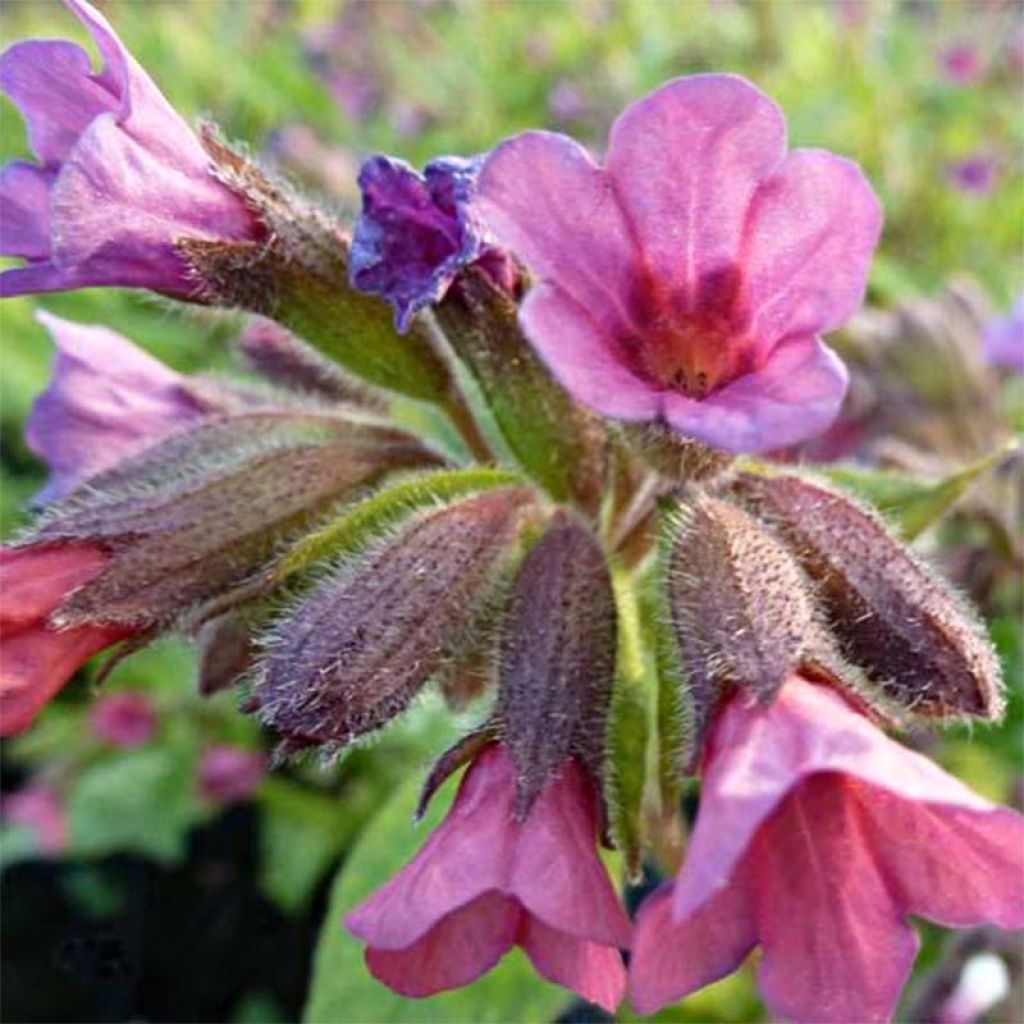

Pulmonaria Victorian Brooch - Lungwort
Pulmonaria Victorian Brooch - Lungwort
Pulmonaria Victorian Brooch
Lungwort
Placée dans un coin ombragé, elle a immédiatement repris. Elle est en flower. Brilliant !!!
marie hélène, 05/03/2021
This item cannot be shipped to the selected country
Delivery charge from €5.90
More information
Schedule delivery date,
and select date in basket
This plant carries a 12 months recovery warranty
More information
We guarantee the quality of our plants for a full growing cycle, and will replace at our expense any plant that fails to recover under normal climatic and planting conditions.
From €5.90 for pickup delivery and €6.90 for home delivery
Express home delivery from €8.90.
Does this plant fit my garden?
Set up your Plantfit profile →
Description
The Victorian Brooch Lungwort is a lovely variety whose small blue flowers quickly turn magenta pink, creating an interesting bicolour effect on a carpet of silver-grey leaves speckled with silver, most often evergreen. This very hardy perennial forms a delightful ground cover in cool and humus-rich soils, bringing lots of whimsy to shaded areas of the garden. This plant blooms throughout spring, accompanying daffodils, periwinkles and wood hyacinths .
The Pulmonaria saccharata, also known as the Spotted Lungwort, is a fully hardy herbaceous perennial plant, belonging to the same family as borage and brunnera, the boraginaceae family. It is a botanical species native to semi-open wooded areas of Europe and Asia, which has given rise to many cultivars with silver-speckled foliage, including the 'Victorian Brooch' variety.
The 'Victorian Brooch' variety is distinguished by its blue flowers quickly turning pink-purple. This rhizomatous plant forms a 30 cm (12in) high carpet in bloom and spreads laterally without any theoretical limit. The leaves, gathered in a flat rosette, are very hairy and about 25 cm (10in) long. They are lanceolate, pointed at the top and rounded at the base, while those of the flowering stems are alternate, elongated and without petioles. Their color is a fairly light grey-green, punctuated by small light spots, white-silver in colour. From April to June, angular, branching stems covered with rough hairs emerge just above the foliage. They bear pendulous cymes of tubular flowers, 5 to 10 mm (<1in) wide, blue at opening, then pinkish-violet, with a deeper throat. The creeping rhizome of lungworts produces new tufts of leaves after flowering, expanding the colony.
A perennial and fully hardy, this lungwort is mainly used as ground cover. In winter, in well-protected areas, its foliage is often evergreen. It will quickly add a splash of colour to exhausted soil under trees, bushes, along facades or north or east-facing alleys, at the base of sunless walls. This plant is a blessing in cool climates, where few plants will grow, such as Caucasian comfrey and large periwinkle. It nicely fills shady flower beds and even thrives under conifers. Plant some spring bulbs that will bloom here and there with your lungwort. Also consider mixing your flower bed with ground covers that bloom later, such as brunneras, Waldsteinia ternata, or perennial Geranium nodosum.
Report an error about the product description
Pulmonaria Victorian Brooch - Lungwort in pictures
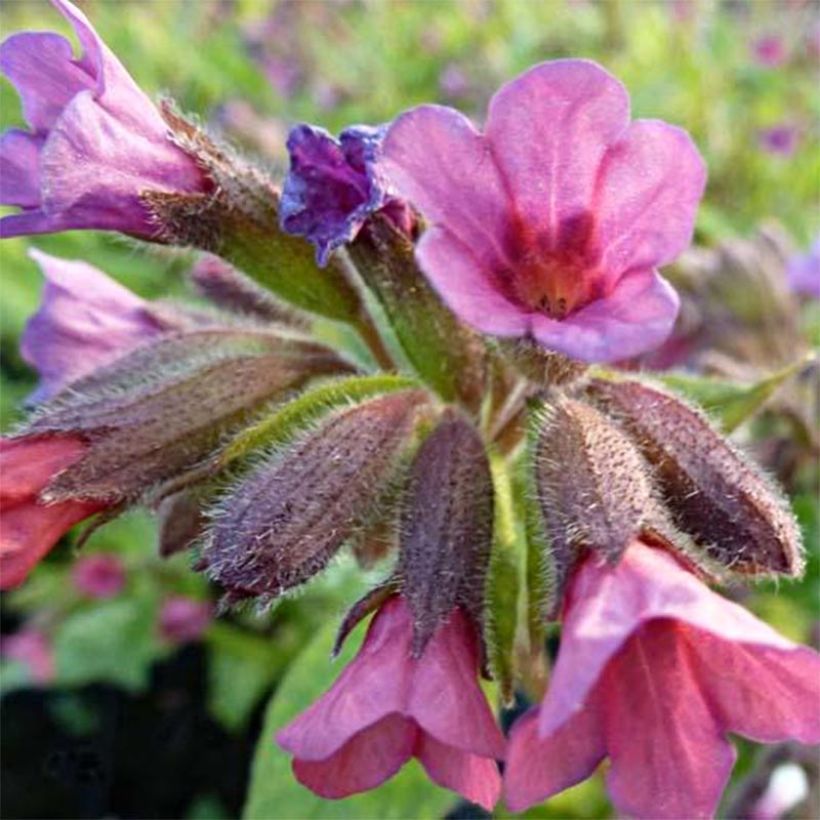



Flowering
Foliage
Plant habit
Botanical data
Pulmonaria
Victorian Brooch
Boraginaceae
Lungwort
Cultivar or hybrid
Other Pulmonaria - Lungwort
Planting and care
Lungworts are good perennial plants for cool climates, as they fear heat and drought, which make them susceptible to fungal diseases. They are very hardy and enjoy leafy undergrowth where they find the necessary spring moisture and, as they bloom early, sufficient light before the trees have their leaves. They are not afraid of limestone and they all like a moist but well-drained humus soil, which is often the case in a clear undergrowth, where the humus of dead leaves nourishes them and the tree roots drain excess water. That being said, they also accept a shady situation on the edge of a flower bed, and manage to grow in heavy and clayey soils. In our garden, we use them a lot to accompany hostas, primroses, small astilbes, astrantias, or even to fill the base of bushes.
Note that during dry summers, the lungwort loses its leaves but new shoots will appear as soon as the rains return.
Planting period
Intended location
Care
-
, onOrder confirmed
Reply from on Promesse de fleurs
Spring flowering perennials
Haven't found what you were looking for?
Hardiness is the lowest winter temperature a plant can endure without suffering serious damage or even dying. However, hardiness is affected by location (a sheltered area, such as a patio), protection (winter cover) and soil type (hardiness is improved by well-drained soil).

Photo Sharing Terms & Conditions
In order to encourage gardeners to interact and share their experiences, Promesse de fleurs offers various media enabling content to be uploaded onto its Site - in particular via the ‘Photo sharing’ module.
The User agrees to refrain from:
- Posting any content that is illegal, prejudicial, insulting, racist, inciteful to hatred, revisionist, contrary to public decency, that infringes on privacy or on the privacy rights of third parties, in particular the publicity rights of persons and goods, intellectual property rights, or the right to privacy.
- Submitting content on behalf of a third party;
- Impersonate the identity of a third party and/or publish any personal information about a third party;
In general, the User undertakes to refrain from any unethical behaviour.
All Content (in particular text, comments, files, images, photos, videos, creative works, etc.), which may be subject to property or intellectual property rights, image or other private rights, shall remain the property of the User, subject to the limited rights granted by the terms of the licence granted by Promesse de fleurs as stated below. Users are at liberty to publish or not to publish such Content on the Site, notably via the ‘Photo Sharing’ facility, and accept that this Content shall be made public and freely accessible, notably on the Internet.
Users further acknowledge, undertake to have ,and guarantee that they hold all necessary rights and permissions to publish such material on the Site, in particular with regard to the legislation in force pertaining to any privacy, property, intellectual property, image, or contractual rights, or rights of any other nature. By publishing such Content on the Site, Users acknowledge accepting full liability as publishers of the Content within the meaning of the law, and grant Promesse de fleurs, free of charge, an inclusive, worldwide licence for the said Content for the entire duration of its publication, including all reproduction, representation, up/downloading, displaying, performing, transmission, and storage rights.
Users also grant permission for their name to be linked to the Content and accept that this link may not always be made available.
By engaging in posting material, Users consent to their Content becoming automatically accessible on the Internet, in particular on other sites and/or blogs and/or web pages of the Promesse de fleurs site, including in particular social pages and the Promesse de fleurs catalogue.
Users may secure the removal of entrusted content free of charge by issuing a simple request via our contact form.
The flowering period indicated on our website applies to countries and regions located in USDA zone 8 (France, the United Kingdom, Ireland, the Netherlands, etc.)
It will vary according to where you live:
- In zones 9 to 10 (Italy, Spain, Greece, etc.), flowering will occur about 2 to 4 weeks earlier.
- In zones 6 to 7 (Germany, Poland, Slovenia, and lower mountainous regions), flowering will be delayed by 2 to 3 weeks.
- In zone 5 (Central Europe, Scandinavia), blooming will be delayed by 3 to 5 weeks.
In temperate climates, pruning of spring-flowering shrubs (forsythia, spireas, etc.) should be done just after flowering.
Pruning of summer-flowering shrubs (Indian Lilac, Perovskia, etc.) can be done in winter or spring.
In cold regions as well as with frost-sensitive plants, avoid pruning too early when severe frosts may still occur.
The planting period indicated on our website applies to countries and regions located in USDA zone 8 (France, United Kingdom, Ireland, Netherlands).
It will vary according to where you live:
- In Mediterranean zones (Marseille, Madrid, Milan, etc.), autumn and winter are the best planting periods.
- In continental zones (Strasbourg, Munich, Vienna, etc.), delay planting by 2 to 3 weeks in spring and bring it forward by 2 to 4 weeks in autumn.
- In mountainous regions (the Alps, Pyrenees, Carpathians, etc.), it is best to plant in late spring (May-June) or late summer (August-September).
The harvesting period indicated on our website applies to countries and regions in USDA zone 8 (France, England, Ireland, the Netherlands).
In colder areas (Scandinavia, Poland, Austria...) fruit and vegetable harvests are likely to be delayed by 3-4 weeks.
In warmer areas (Italy, Spain, Greece, etc.), harvesting will probably take place earlier, depending on weather conditions.
The sowing periods indicated on our website apply to countries and regions within USDA Zone 8 (France, UK, Ireland, Netherlands).
In colder areas (Scandinavia, Poland, Austria...), delay any outdoor sowing by 3-4 weeks, or sow under glass.
In warmer climes (Italy, Spain, Greece, etc.), bring outdoor sowing forward by a few weeks.


































